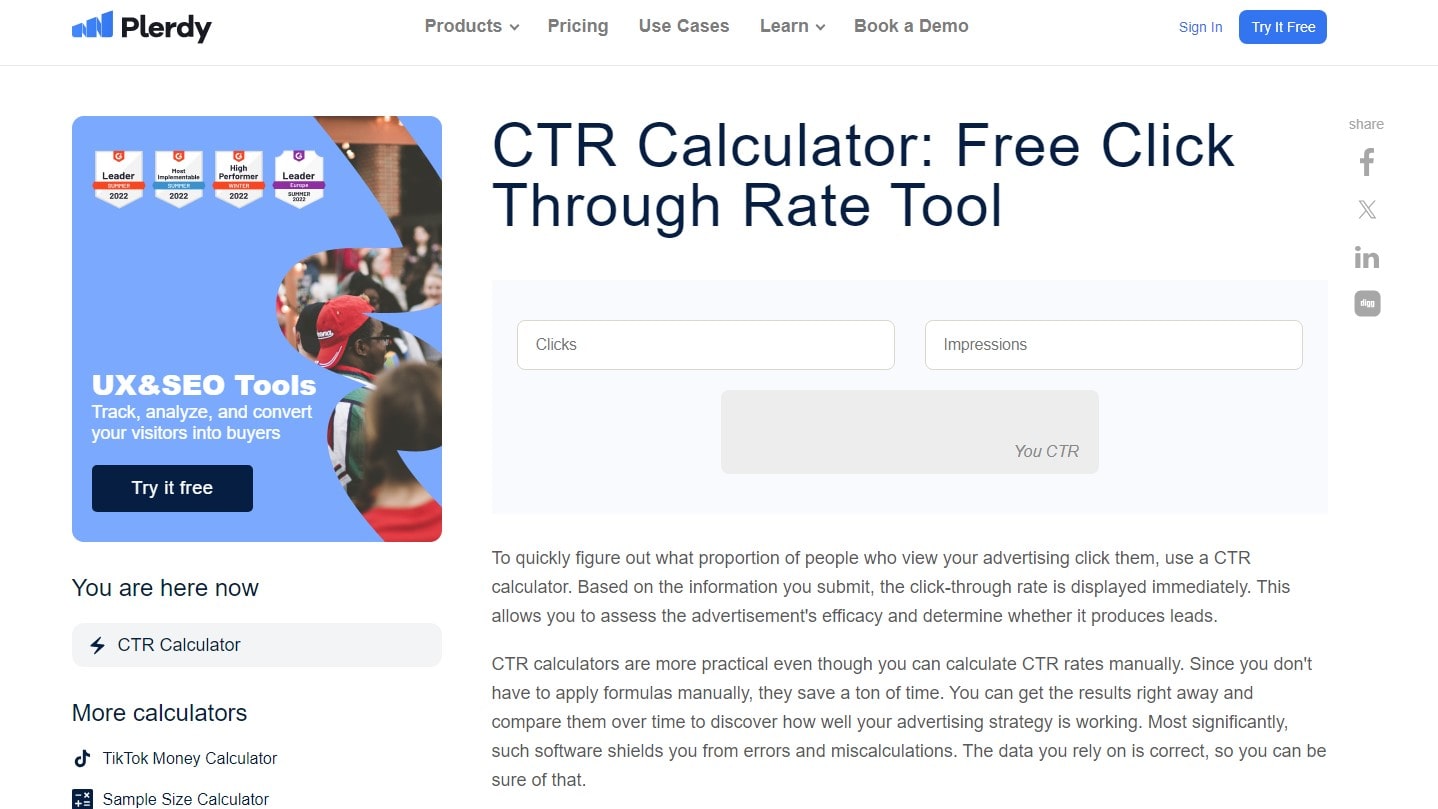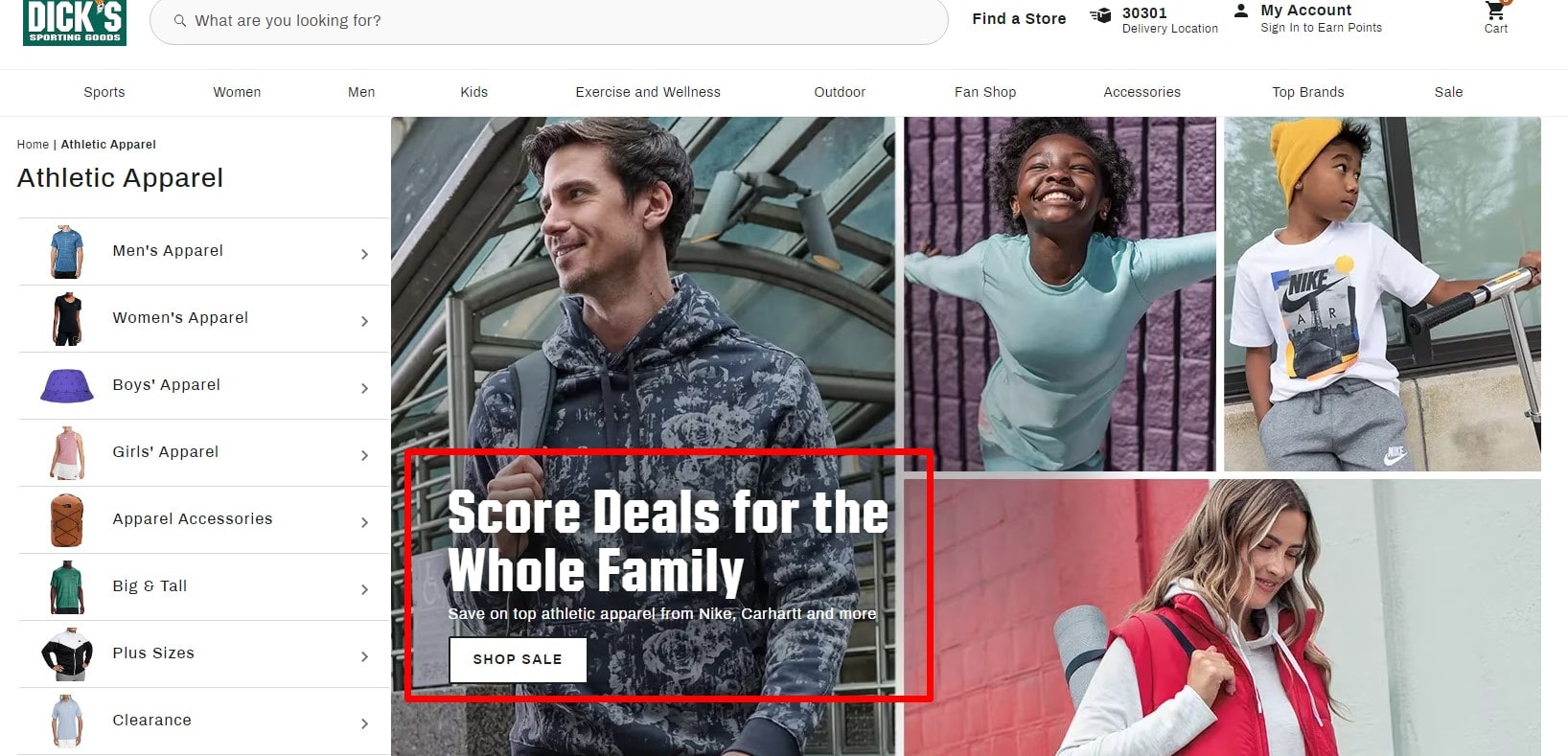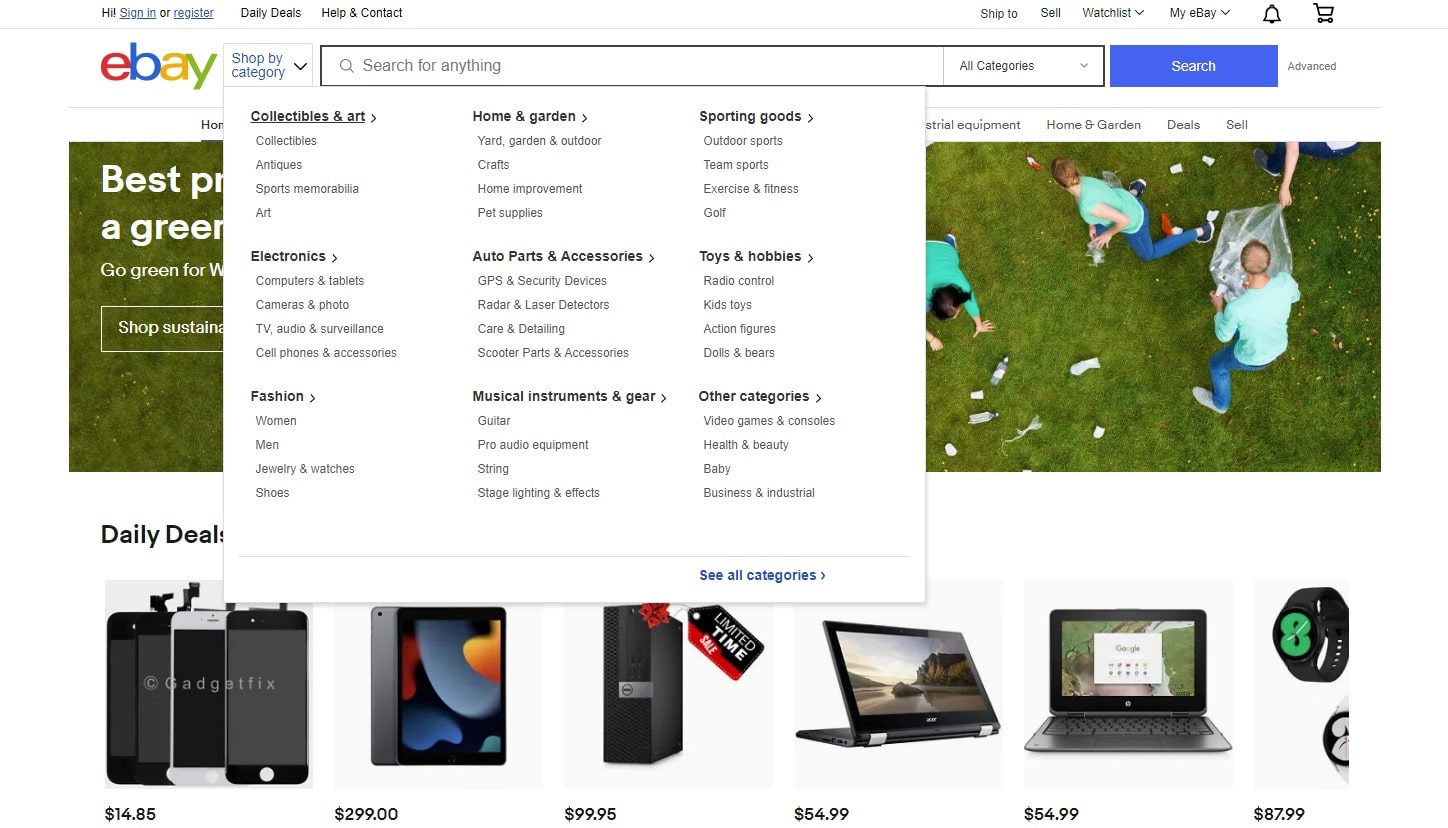When it comes to mastering the digital landscape, understanding click-through rate (CTR) remains pivotal. This invaluable metric—CTR—offers a snapshot of your content’s effectiveness, revealing how often users click after seeing a link or ad. Breaking down CTR empowers you to tweak your strategies, optimizing for peak performance.
Let’s dive into the essentials:
- Click-through: The action of a user clicking a link or ad after viewing it.
- Rate: Essentially, a ratio indicating the frequency of those click-throughs relative to the total views.
- CTR: The marriage of click-through and rate – showcasing the percentage of clicks to views.

To truly harness the potential of CTR, it’s crucial to embrace tools that enrich user experience and conversion rate optimization. Why not give Plerdy a spin? This dynamic tool elevates CRO & UX, ensuring your CTR doesn’t just climb—it thrives! 🌟📈
With a grasp on click-through and rate dynamics, and with CTR as your guide, you’re poised to steer your digital ship confidently through the vast ocean of online opportunities.
Definition of Click-through Rate: Importance in Digital Marketing
Click-through rate, often abbreviated as CTR, stands at the heart of digital marketing. It provides a snapshot of campaign effectiveness, revealing the percentage of viewers who clicked an ad or link after seeing it. As businesses strive to capture audience attention amidst a sea of online content, an impressive CTR serves as a beacon indicating resonance with the target audience.
Consider these facets of CTR’s significance:
- Engagement Gauge: A robust CTR signals that your content hits the mark. For instance, in the e-commerce sector, a compelling product ad might enjoy higher click-through rates because it resonates with shoppers’ preferences.
- Cost Efficiency: Especially in pay-per-click campaigns, where businesses fork out cash for every click, a stellar CTR ensures you’re getting bang for your buck. Take the travel industry, for example. A well-crafted ad about tropical vacations might drive more clicks – and more bookings – compared to a generic ad.
- Brand Resonance: When people choose to click through, they’re essentially expressing interest. Brands that consistently achieve commendable CTRs ensure their voice stands out in crowded markets, like the saturated beauty industry, where consumers are bombarded with countless ads daily.
Tweaking ads or content to boost the click-through rate can be the difference between a mediocre campaign and a roaring success. Digital marketers, always on the hunt for optimization, hold CTR in high regard – it’s more than just a metric. It’s an affirmation of a message’s potency, a nod to the ad’s allure, and a testament to a brand’s digital prowess.
How Click-through Rate is Calculated: Formula for CTR

Navigating the landscape of digital marketing, one quickly realizes the significance of the click-through rate (CTR). To grasp CTR’s essence, you first need to understand its calculation. CTR is the ratio of link clicks to page or ad views.
Let’s break down the formula:
- CTR Formula: (Total Click-throughs / Total Impressions) x 100
To illustrate, consider this example:
- An online shoe retailer posts an ad.
- The ad generates 1,000 views (impressions).
- Out of these, 50 users click on the ad.
- Using the formula, the CTR would be: (50/1000) x 100 = 5%
Understanding the click-through rate offers marketers a clear window into ad effectiveness. A high CTR often indicates that your audience finds the ad relevant. However, a low CTR might suggest the opposite. In niches like e-commerce, a shoe ad with a stellar CTR shows that the design and copy resonate with viewers. On the flip side, a bookstore with a dwindling CTR might need to revamp its approach.
In conclusion, mastering the calculation and implications of CTR paves the way for more refined, targeted, and successful marketing campaigns. After all, it’s not just about catching eyes – it’s about prompting action.
Factors Influencing CTR
In the vast digital landscape, understanding the elements that affect click-through rate (CTR) becomes crucial for marketers aiming to optimize their campaigns. The rate at which users engage with content, ads, or any clickable entity can be influenced by various factors, both overt and subtle.
Here are the primary culprits that can make or break your CTR:
- Ad Relevance: A mismatch between what’s promised in an ad and the landing page can lead to a drop in CTR. For instance, an e-commerce site promoting organic skincare but directing users to synthetic products will see a dip in its rate.
- Visual Appeal: Crisp graphics, compelling images, and professional designs can skyrocket engagement. Recall the fashion industry, where visually striking ads ramp up the CTR, making users eager to explore the latest collections.
- Copy Clarity: A well-crafted headline paired with concise, actionable text pulls in more clicks. A travel agency enticing users with “Savor a tropical escape” will undoubtedly get more traction than a vague “Holiday deals inside”.
- Placement and Position: Positioning an ad at a page’s strategic hotspot boosts its visibility. An ad nestled within quality content or above the fold generally garners a higher CTR.
Ultimately, while understanding the factors influencing CTR is essential, continual adjustments and testing can truly hone a campaign. By keeping tabs on these variables and refining them, brands can steadily drive up their rate and ensure their digital endeavors thrive.
The Role of CTR in Search Engine Optimization (SEO)
Diving into the intertwined relationship between click-through rate (CTR) and Search Engine Optimization (SEO) reveals a dynamic interplay. At the junction of user behavior and search engine algorithms, CTR emerges as a pivotal metric that significantly impacts SEO efforts.
First, understand the subtle yet profound ways CTR weaves into the SEO tapestry:
- User Engagement Indicator: A high CTR suggests your content resonates with users. For instance, in the food blogging sector, a tantalizing recipe title can ramp up click-through rates, hinting at its appeal to culinary enthusiasts.
- Feedback Loop to Search Engines: When users frequently click on a specific result for a query, search engines pick up on this preference. Imagine a niche like sustainable fashion; if a particular article about eco-friendly materials consistently gets high click-through rates, it signals its relevance to search engines.
- Improved Rankings Potential: Over time, an elevated CTR can bolster content positioning. An article on urban gardening, grabbing attention with its enticing meta description, can climb search rankings if its click-through outperforms competitors.
- Refinement of SEO Strategies: Monitoring CTR helps in fine-tuning SEO tactics. If a tech review site notices dwindling click-through for its smartphone reviews, it can reevaluate its headline strategy or meta descriptions to re-engage its audience.
Yet, it’s crucial to strike a balance. While optimizing for CTR, the content’s quality shouldn’t take a backseat. Serving user intent remains paramount. In the realm of online education, a course title might attract high click-through, but if the content doesn’t deliver, users bounce back—another metric search engines keenly observe.
In essence, CTR and SEO dance a delicate duet. Marketers adeptly leveraging both can carve out a compelling digital narrative, ensuring their content doesn’t just show up but shines brightly in the vast expanse of the web.
Best Practices to Optimize CTR

Harnessing the potential of click-through rate (CTR) requires a blend of art and strategy. For those keen on elevating their CTR game, a few tried-and-true tactics stand out. Here’s a curated list of best practices tailored to optimize click-through rates:
- Craft Compelling Headlines: In the world of travel blogging, a headline like “Undiscovered Beaches of Bali” can magnetize readers, driving up click-through.
- Engage with Authentic Visuals: For e-commerce brands selling artisan jewelry, high-quality images capturing the product’s intricate details can significantly boost the click-through rate.
- Incorporate Clear CTAs: In financial services, a distinct call-to-action such as “Unlock Premium Investment Insights” can lead to a spike in click-through rates compared to a generic “Click Here.”
- Segment and Personalize: Email campaigns for subscription box services, when tailored to individual preferences—say, “vegan beauty products” or “gourmet teas”—often see elevated CTR.
- Test, Tweak, Repeat: Run A/B tests on your ad creatives or email subjects. In the fitness niche, for instance, experimenting with different workout video thumbnails can unveil which one captivates more clicks.
Each sector has its nuances, but the underlying principle remains consistent: understand your audience, and tailor your approach to resonate. As digital landscapes evolve, so too must the tactics deployed to captivate and convert. By delving into these best practices, marketers can sharpen their strategies, refining their approach to not only attract eyeballs but to entice those all-important clicks in a fiercely competitive digital ecosystem.
Crafting Compelling Ad Copy
Elevating click-through rates (CTR) pivots on the prowess of the ad copy. In the bustling marketplace of digital ads, standing out is both an art and a science. A compelling ad copy doesn’t merely describe; it entices, engages, and evokes action. Consider these crucial tactics to boost CTR through your ad copy:
- Highlight Unique Value: For boutique wineries, emphasizing “handpicked, sun-ripened grapes” can spike click-through rates, drawing in aficionados seeking quality over quantity.
- Speak Directly to Pain Points: A home security company might underscore “24/7 surveillance for peace of mind,” tapping into homeowners’ safety concerns and pushing up the CTR.
- Use Action-Oriented Language: In the fitness niche, phrases like “melt away calories” or “sculpt your core” drive click-through by painting a vivid outcome.
- Stay True to Brand Voice: A luxury watch brand emphasizing craftsmanship might tout “centuries-old horology traditions” to lure discerning collectors and enhance CTR.
Crafting a click-worthy ad copy is akin to tailoring a suit—it must fit the audience just right, resonate with their desires, and stand out in a crowd. Dive into the nuance, refine with precision, and watch the click-through rate climb.
A/B Testing for Ad Variations
Navigating the intricate waters of ad optimization demands a meticulous approach. A/B testing emerges as a cornerstone strategy, pinpointing which ad variations ramp up click-through rates (CTR). It’s about honing in on subtle differences that create a ripple effect on click-through outcomes.
Consider these illustrative scenarios to understand the gravity of A/B testing:
- Color Conundrums: An e-commerce brand selling sustainable footwear might experiment with a serene blue versus a vibrant green “Buy Now” button. The outcome? One hue might cinch a higher CTR, resonating more with eco-conscious shoppers.
- Headline Hustles: A streaming service rolling out a groundbreaking series could test “Binge the Latest Sensation” against “Dive into Drama’s Best.” Minute tweaks could send click-through rates skyward.
- Imagery Impact: In the health supplement niche, contrasting a chiseled athlete with a zen yogi could yield disparate CTR results, speaking to varied segments of health enthusiasts.
- CTA Craft: For a digital course platform, the tug between “Kickstart Your Learning” and “Unlock Knowledge Today” can make a marked difference in click-through metrics.
Harnessing A/B testing’s power illuminates pathways to refining ad elements, ensuring each pixel, phrase, and placement aligns seamlessly to captivate and convert. By dissecting and analyzing, marketers dial in on the sweet spots that amplify CTR, setting the stage for stellar digital performance.
Using Relevant Keywords and Phrases
Tapping into the pulse of digital audiences requires more than just striking visuals or snappy taglines. At the heart of boosting click-through rates (CTR) lies the strategic use of keywords and phrases. Pinpoint accuracy in keyword selection amplifies ad relevance, ushering in a surge of click-through activity.
Grasp the essence with these real-world scenarios:
- Gourmet Galore: For an artisanal bakery, weaving in terms like “handcrafted sourdough” or “organic multigrain loaf” can skyrocket CTR by catering to discerning bread enthusiasts.
- Travel Trails: A boutique travel agency might sprinkle phrases such as “hidden mountain retreats” or “unspoiled beach havens” to draw in explorers, driving a noticeable uptick in click-through.
- Tech Talks: Launching a cutting-edge app? Integrating terms like “intuitive interface” or “lightning-fast load times” can push tech aficionados to click through with enthusiasm.
- Eco Emphasis: A brand championing sustainable fashion stands to boost CTR by infusing “eco-friendly fabrics” or “conscious couture” into their content.
Incorporating these tailored terms enhances ad resonance, ensuring you’re not just reaching an audience—but the right audience. It’s a dance of aligning product offerings with consumer aspirations. By doing so, click-through rates naturally climb, as ads transform from mere visuals into resonant messages that audiences eagerly engage with.
Leveraging Visual Elements Effectively
Diving into the digital landscape, it becomes clear that visuals play a pivotal role in driving click-through rates (CTR). But it’s not just about slapping on any image. Harnessing the power of effective visual elements can make or break the click-through rate of your content. When thoughtfully integrated, these elements not only grab attention but also spur action, boosting CTR in the process.
Let’s break down visual nuances across industries:
- Health and Wellness: Displaying serene imagery – think sunlit yoga poses or misty mountain treks – can entice wellness enthusiasts to delve deeper, enhancing click-through.
- Automotive Edge: High-resolution shots of sleek car curves, shimmering finishes, or dynamic drives captivate automotive buffs, driving up CTR.
- Culinary Creations: Plating up mouthwatering dishes, with vibrant colors and tantalizing textures, can lead foodies to click through, hungry for more.
- Home Decor Dreams: Showcasing cozy corners, artful arrangements, or modern motifs can resonate with home enthusiasts, nudging the click-through rate upward.
Tailoring your visual approach to the intended audience is crucial. By syncing your imagery with audience preferences, you can turn passive viewers into engaged clickers. The result? Your content doesn’t just get seen—it gets acted upon. In the dance of digital engagement, visual cues lead the way, turning the spotlight on higher click-through rates and meaningful audience connections.
The Limitations of Relying Solely on CTR

Diving deep into the metrics that shape digital success, it’s tempting to put click-through rate (CTR) on a pedestal. After all, a boosted CTR can often signal an engaging headline or a captivating ad. But, like any single metric, leaning too heavily on CTR paints an incomplete picture of overall performance. There’s a broader narrative to consider, especially when you scratch beneath the surface.
Consider these nuances from various industries:
- E-commerce Powerhouses: A high click-through rate might bring heaps of visitors to a product page. Yet, if they don’t convert into sales, the revenue needle remains stationary.
- Blog Brilliance: While a compelling headline can skyrocket CTR for a blog post, it doesn’t guarantee that readers stick around, engage with the content, or share it.
- App Advertisements: Sure, potential users might click through an ad at impressive rates. However, if they don’t download or engage with the app, it’s a hollow victory.
- Online Courses: A snazzy course advertisement may increase click-through, but without sign-ups or course completions, it’s just window shopping.
Relying solely on CTR sidesteps the layered journey of user engagement. It’s essential to pair CTR with other metrics like conversion rates, bounce rates, and user behavior analytics. By integrating a spectrum of insights, brands and businesses can craft a more holistic strategy – one that goes beyond mere clicks and dives into genuine engagement and value. In the intricate dance of digital metrics, CTR is just one step in the choreography.
CTR vs. Conversion Rate
In the bustling digital marketplace, understanding metrics is pivotal. While both click-through rate (CTR) and conversion rate stand tall in this arena, they spotlight distinct aspects of user behavior and engagement.
Dive into these distinctions from key industries:
- Streaming Services: A high CTR might lead viewers to a movie trailer. Yet, without subscription sign-ups – the real benchmark – it’s all sizzle and no steak.
- Fashion Retailers: Stellar CTR could mean your ad campaign catches the eye. But if those clicks don’t translate into purchases, the wardrobe stays full and untouched.
- E-book Publishers: An enticing title might pull readers in with an impressive click-through. However, without actual downloads or purchases, the story remains unread.
While CTR measures the allure of your content – essentially acting as a digital magnet – conversion rate dives into action, capturing the percentage of visitors who take a desired step, be it a purchase, sign-up, or download. It’s like comparing a handshake to a signed contract. Both are part of the business dance, but one commits more than the other.
In the grand tapestry of digital engagement, intertwining CTR with conversion rate insights paints a richer, fuller picture. It’s not just about drawing them in; it’s about sealing the deal. In this intricate ballet of metrics, understanding each step ensures you don’t just lead, but also follow through to the finale.
Potential Misleading Scenarios with High CTRs
A high click-through rate (CTR) often paints a picture of success, leading marketers to believe their content or ads hit the mark. However, several scenarios can inflate the CTR without translating to genuine engagement or returns.
Consider these deceptive instances:
- Misleading Titles: A title that promises one thing but delivers another can inflate CTR. Imagine a health website claiming a “Revolutionary Diet Plan” only to pitch a generic weight-loss program. Users might click out of curiosity, but the bounce rate will spike when content falls short.
- Ad Positioning: Placing ads in high-traffic zones, such as pop-ups, can force users to click unintentionally. For instance, placing an intrusive pop-up ad on a mobile game screen might cause accidental clicks, distorting the CTR.
- Vague Descriptions: Crafting vague or ambiguous copy might pique user interest temporarily. Think of a tech blog teasing “Latest Tech Unveiled” without any context. Such ambiguity can draw clicks, but may fail to retain interest.
Marketers should always drill down into data, understanding the context behind a high CTR. By distinguishing between genuine engagement and misleading metrics, brands can craft strategies that not only optimize rate but also foster authentic user interest.
Other Important Metrics to Consider
While the allure of a high click-through rate (CTR) can be enticing, it’s just one piece of the broader digital marketing puzzle. Sole reliance on CTR can make you miss out on the holistic view of campaign performance. Let’s dive into other crucial metrics that offer deeper insights:
- Bounce Rate: If your CTR is sky-high but your audience bounces off quickly from the landing page, you’ve got a mismatch. For instance, a fashion brand might reel in users with trendy ads, but if the linked page is outdated, they’ll bail.
- Average Session Duration: High click-through doesn’t mean they’re sticking around. An e-book platform could have an impressive CTR, but if users don’t spend time browsing, it indicates shallow engagement.
- Page Views per Session: A stellar CTR is hollow if users don’t explore further. Imagine a travel site with a high CTR for a tropical destination, but low page views — it suggests they aren’t enticed to plan their journey.
- Conversion Rate: Arguably the most vital, this metric indicates action beyond the click. A pet supply store might boast a remarkable rate, but if those clicks don’t result in sales or sign-ups, the campaign needs reevaluation.
It’s imperative to pair CTR with these deeper dives. By doing so, you get a comprehensive understanding, allowing for nimble adjustments and crafting campaigns that not only attract clicks but also drive meaningful outcomes.
Conclusion
Wrapping up the intricacies of click-through rate (CTR) has been quite a journey! By now, the pivotal role of CTR in the vast sea of online metrics should be evident. Whether it’s assessing the effectiveness of emails, tracking user interactions on social media, or adjusting advertising strategies on platforms like Google and YouTube, the rate at which users click-through is a paramount indicator. 📊✨
Quick recap:
- Click-through: The act of a user engaging with embedded content, be it on emails, media hubs, or http pages.
- Rate: A ratio symbolizing the persistence of users, as they interact with content they come across.
- CTR: A marriage of the two – shining a light on the effectiveness of your content and strategy.
For those in the business sphere – from advertisers to community managers – diving deep into tools that offer insight is essential. Plerdy, for instance, brings to the table unparalleled SEO & UX analysis. A digital companion that’s a force to reckon with for every advertiser and marketer out there. 🛠️🌐
Remember, as the digital world evolves and adjusts, staying updated with CTR metrics ensures your strategies remain top-notch and relevant. Dive into tools, stay informed, and keep your strategies fresh!
